Front Loop to Toe side
Front Loop to Toe side
We are starting this subject matter with the front loop to toe side as in fact a simple step to achieve. It isn’t something you see very often and this could help you stand out now that those pesky unhookers can’t keep hold of their bars. Doing a front loop can be measured for a high or a low loop, and once it is in the bag, you can accomplish variety of combos.
As you might have guessed, the foundation is front loop with the usage of kite, so if you are not satisfied with these, combine them first before moving on. However, many surfers find landing on one side is a difficult task. Well, this move could be the answer to your front loop prayers.
Proving a point
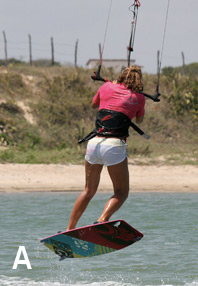 Pic A. The surfer performs a front loop to toe side riding from left to right. This means that the surfer will be kicking off the left leg for take-off but will be landing on the right leg. You can see that the surfer is in the after take-off moment, it is precisely the same movement of kite and body as for a standard front loop. Having approached with good speed provides a good edge for sending the kite back. As usual, the surfer takes-off and initiates the front loop by throwing the head and shoulder down and around kicking the back foot.
Pic A. The surfer performs a front loop to toe side riding from left to right. This means that the surfer will be kicking off the left leg for take-off but will be landing on the right leg. You can see that the surfer is in the after take-off moment, it is precisely the same movement of kite and body as for a standard front loop. Having approached with good speed provides a good edge for sending the kite back. As usual, the surfer takes-off and initiates the front loop by throwing the head and shoulder down and around kicking the back foot.
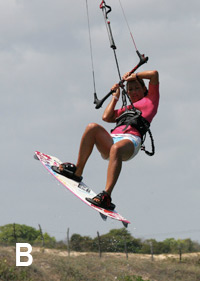 Pic B. Here it shows that the surfer is about half way through her front rotation. To land toe side you will need to land on the right foot. To accomplish this, you must push the left foot out in front of you. The simplest way to get this move is to keep the original back leg straight as you rotate. You need to bend your front leg to rotate forward and go with the flow. You can see here that the surfer’s left leg is straight and hanging down for landing purposes. All these said moves need a rotation all the way around with the head.
Pic B. Here it shows that the surfer is about half way through her front rotation. To land toe side you will need to land on the right foot. To accomplish this, you must push the left foot out in front of you. The simplest way to get this move is to keep the original back leg straight as you rotate. You need to bend your front leg to rotate forward and go with the flow. You can see here that the surfer’s left leg is straight and hanging down for landing purposes. All these said moves need a rotation all the way around with the head.
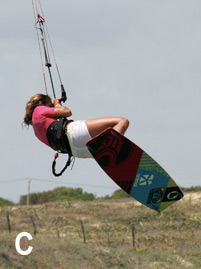 Pic C. The surfer rotates further in order to get into a perfect landing position. But before you land, you need to do a couple of task. Firstly, you need the help of the kite for a pull down to land successfully, so you must keep the bar in and the kite moving forward above by diving with front hand. If you let the bar out, the kite will get left behind and you will drop under it. You also need to prepare for a toe side landing.
Pic C. The surfer rotates further in order to get into a perfect landing position. But before you land, you need to do a couple of task. Firstly, you need the help of the kite for a pull down to land successfully, so you must keep the bar in and the kite moving forward above by diving with front hand. If you let the bar out, the kite will get left behind and you will drop under it. You also need to prepare for a toe side landing.
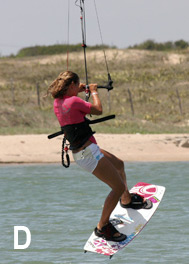 Pic D. As the kite comes over the surfer, the pressure will give a downward force against the water so the board will drop beneath and will be ready for a landing. The trick here is for the surfer to get a bit of weight forwards onto the front of the board to prevent sinking the tail and completely stop.
Pic D. As the kite comes over the surfer, the pressure will give a downward force against the water so the board will drop beneath and will be ready for a landing. The trick here is for the surfer to get a bit of weight forwards onto the front of the board to prevent sinking the tail and completely stop.
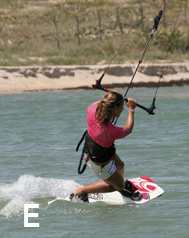 Pic E. Just after touching down, you can see the surfer’s kite is pulling because of the hard dive, which is essential in landing. This means that the surfer landed on relatively flat board thus, maintaining the speed. Now the surfer is able to carve the board onto a true toe side path by dropping weight to windward.
Pic E. Just after touching down, you can see the surfer’s kite is pulling because of the hard dive, which is essential in landing. This means that the surfer landed on relatively flat board thus, maintaining the speed. Now the surfer is able to carve the board onto a true toe side path by dropping weight to windward.
Sequences in Summary
1. The surfer approaches with speed on a solid edge with the kite around 1 o’clock. The surfer sends the kite back with an aggressive pull on back hand and edges harder by turning upwind.
2. As the kite lifts, the surfer performs the front rotation, kicking off the back heel and throwing the head and shoulders down around while keeping the bar in.
3. The surfer concentrates on redirecting the kite by pulling gently on front hand while going up.
4. The surfer focuses to prevent rear leg to get up.
5. The surfer keeps looking over the back shoulder in order to keep turning.
6. Half way around, the surfer places the kite above, so pulling it on front is the best way. Rear leg straight and front leg bent.
7. As the surfer estimates the landing position, he aims to start diving the kite to help the pulling force for the move and also for a downwind momentum.
8. The surfer is ready for the toe side, so pulling the right leg up is appropriate.
9. As the surfer goes down, the surfer must keep the tension on the lines so that the kite could gain a pulling effect and the surfer can keep the bar in.
10. The surfer drops feet underneath by extending legs and concentrating on keeping the left foot out in front.
11. The surfer aims to land tail first by straightening right leg underneath.
12. As the board touches down, the surfer’s forward momentum from the dive will keep the bar in, so pulling it forward is the clear way.
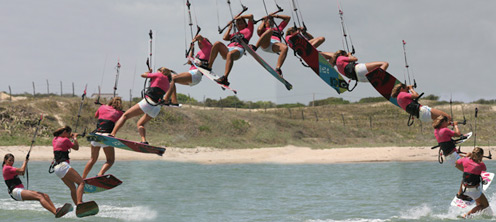
Best Tips
Bring your front foot all the way the landing event. Landing toeside paves way to complete a front loop. Your shoulders need to turn so that facing forward will not be hard, so go for the full rotation even though it may not look like one.
Common Problems
1. Getting your body to toe side needs a lot of effort at first because you are trying to twist your back shoulder past the bar and the chicken loop. The solution is to keep pulling right up to the bar and let the kite do the work.
2. Performing the toe side can be very delicate at first attempt, so focus on pulling the diving kite at the landing position and control your shoulder back for the rotation. Once you have your mind and body in a perfect state, this should be easy.
Key Points
1. Send the kite
2. Throw the rotation
3. Keep back leg straight
4. Pull front leg under your buttock
5. Dive the kite hard
Here´s what it should look like in real time!
Leave a Reply